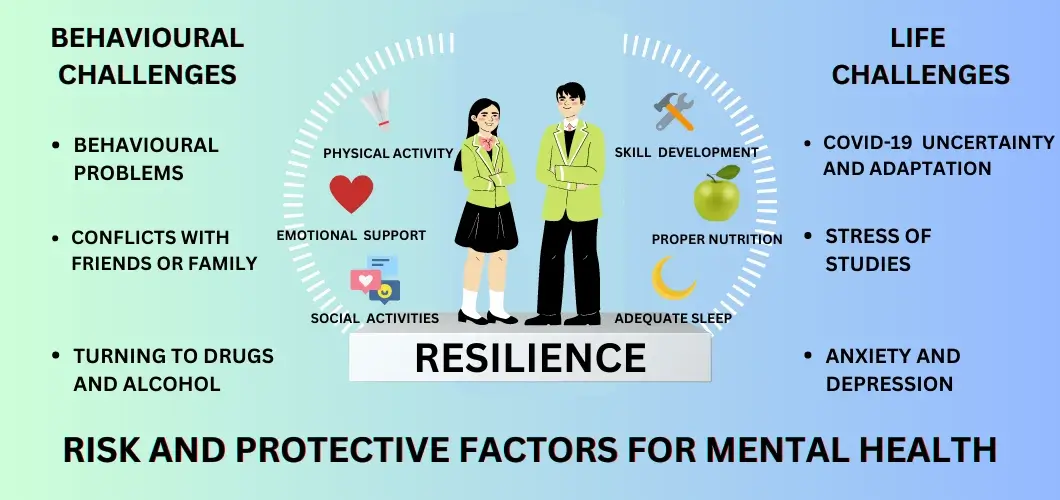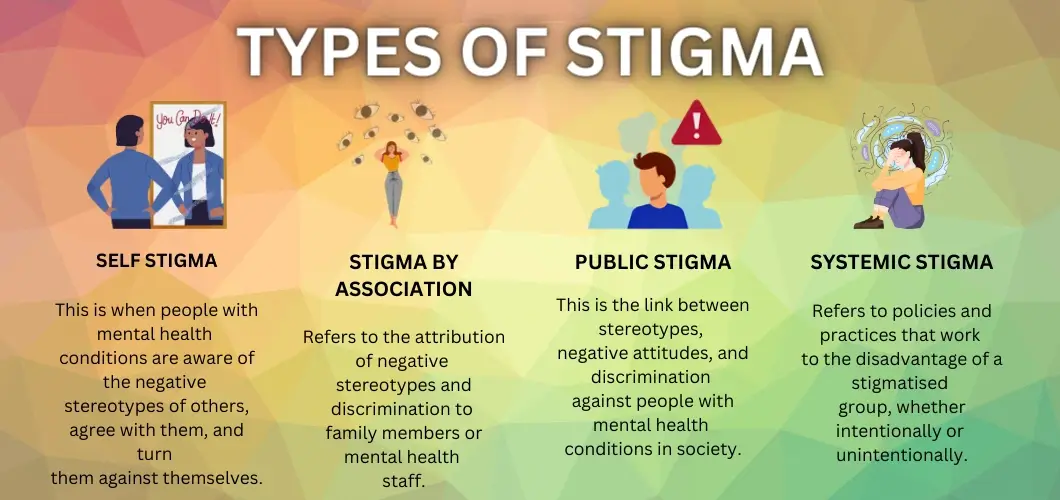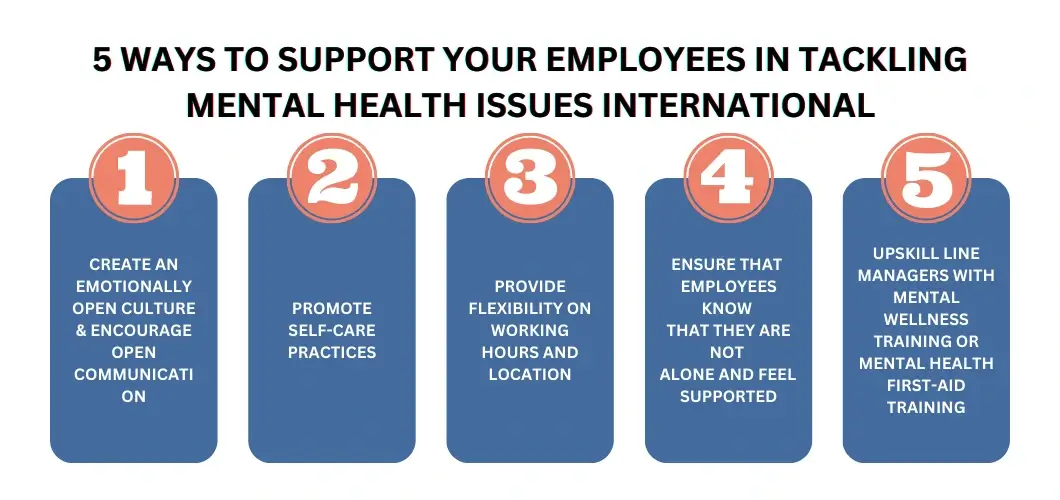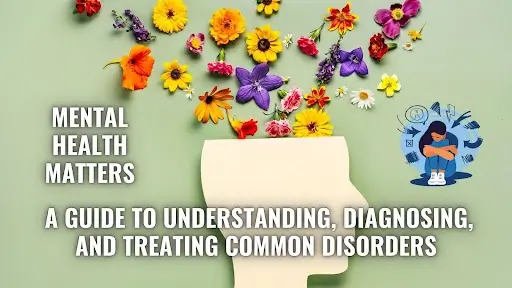- Definition
- Facts
- Why Is Mental Health Important?
- Disorders
- Risk And Protective Factors
- Early Signs
- Mental Health Symptoms Checklist
- Diagnosis
- Treatment
- Maintaining Mental Health
- Overcoming Mental Health Stigma
- Improve Mental Health In The Workplace?
- Facilities Near me
Mental Health Matters: A Guide to Understanding, Diagnosing, and Treating Common Disorders
Mental health is all about how people think, feel, and behave, and can affect daily living, relationships, and physical health. There are various mental health disorders, such as anxiety disorders, mood disorders, and schizophrenia disorders.
Mental health is an essential component of people’s lives. Poor mental health can impact our well-being and our relationships with family, friends, and society.
Looking after one’s mental health can help a person preserve their ability to enjoy life.
In this blog, we will explain what mental health is, what the various types of mental health disorders are, and how to combat them.
What Is Mental Health- An Introduction
According to the World Health Organization, Mental health is a state of mental well-being that helps a person get through the stresses of life, realize their abilities, work well, learn well, and contribute to their society.
It is a fundamental component of well-being and health that underpins our collective and individual abilities to build relationships, make decisions, and shape the world we live in [1].
Mental health disorders disrupt everyday activities, thus making it important to pay attention and care [2].
Mental Health Facts
- The National Alliance on Mental Illness estimates that around 1 in 5 adults in the United States suffer from mental health issues each year [3].
- One in every five Americans suffers from mental health disorders in a given year.
- 1 in every 6 young individuals experiences a major depressive episode.
- One in 20 Americans suffers from serious mental health disorders like major depression, schizophrenia, and bipolar disorder.
- Over 800,000 deaths from suicide occur globally each year, with 41,000 cases alone in the USA. It is also the second leading cause of death worldwide for people between the ages of 15 and 29 years.
- The stigma associated with mental health is a major reason people do not seek treatment. About 44% of adults diagnosed with mental health disorders receive treatment.
Why Is Mental Health Important?
Sound mental well-being is a very important aspect of living a healthy life. It profoundly influences every aspect of our lives. The Mental Health of a person can impact their thoughts, interactions, and actions. It further empowers individuals to build meaningful relationships, navigate challenges, and make informed decisions.
- Increases our self-esteem.
- Reduces our anxiety.
- Improves the mood.
- Helps with thinking more clearly.
- Improves relationships.
- Creates an enhanced sense of inner peace.
Some physical health issues, such as stress and heart problems, are directly linked to mental health conditions. Thus, managing stress and improving your mental health condition can have positive outcomes in promoting a healthy lifestyle.
Types And Causes Of Mental Health Disorders
Mental Health disorders can have a wide range of causes. For most people, it is a combination of factors. Some of the factors that can potentially result in poor mental health are listed below.
- Childhood abuse or trauma.
- Loneliness.
- Poverty or debt.
- Experiencing discrimination.
- Having a long-term physical health condition.
- Drug and alcohol misuse.
- Losing someone close to you.
- Domestic violence or bullying.
The different types of health conditions that can be recognized as mental health issues are-
- Mood Disorders.
- Anxiety Disorder.
- Schizophrenia Disorder.
Mood Disorders
Mood disorders are also referred to as depressive disorders or affective disorders.
People with these conditions have notable mood changes, like mania, periods of joy, high energy, or depression. Some of the mood disorders are discussed below.
-
Bipolar Disorder-
Bipolar disorder is a mood disorder that causes unusual changes in a person’s mood, energy, activity levels, and concentration. These shifts can make it difficult for them to carry out everyday tasks [4].
-
Major Depression-
Major depression is another mood disorder that occurs when feelings of sadness, frustration, loss, or anger get in the way of your life over a long period of time.
-
Seasonal Affective Disorder
It is a type of depression with seasonal patterns. Depressive episodes tend to occur at the same time each year, most commonly during the winter season.
Anxiety Disorders
Experiencing anxiety in stressful situations is a normal part of life. However, people with anxiety disorders have intense, persistent, and excessive worry and fear about day-to-day situations.
Below are some of the most common anxiety disorders.
-
Generalized anxiety disorder
Generalized anxiety disorder is a mental health condition that causes constant feelings of fear and worry, disrupting a person’s quality of life.
-
Panic Disorder
Panic disorder is a type of anxiety disorder where a person regularly has sudden attacks of fear and panic [5].
-
Phobias
A phobia is a type of anxiety disorder that causes a person to experience extreme fear of a living creature, situation, place, or object.
There are different types of fear, such as
- Simple Phobia-
This type of phobia may involve fear of a specific scenario, object, or animal. For example, a fear of cockroaches.
- Agoraphobia-
Agoraphobia is a disorder characterized by symptoms of anxiety in situations where a person thinks their environment is unsafe with no way to escape.
- Social phobia-
Social anxiety is a persistent fear of others watching or judging you.
-
OCD (Obsessive Compulsive Disorder)
Obsessive Compulsive Disorder is a long-lasting and common disorder in which an individual has uncontrollable, recurring thoughts (obsessions) or behaviors (compulsions) that they feel the need to repeat over and over again [6].
According to NIHM (The National Institute of Mental Health), around 2.5 million adults, or 1.2% of the U.S. population, are affected by OCD [7].
-
PTSD (Post-Traumatic Stress Disorder)
PSTD can occur in people after experiencing or witnessing an intensely traumatic or stressful event. In this type of event, the individual thinks that their life is in danger, and they feel afraid or think that they have no control over what is happening.
Post-traumatic Stress Disorder affects around 7.7 million adults, or 3.6% of the population in the United States [7].
Schizophrenia Disorders
Schizophrenia is a serious mental health condition that affects how an individual feels, behaves, and thinks. People with this illness may seem detached from reality, and the symptoms of this condition can make it difficult to participate in everyday activities.
Risk And Protective Factors For Mental Health

Over the last three decades, research has identified various risk factors for mental disorders in children and adults. A significant shift has occurred from viewing risk factors as fixed and specific circumstances to seeing them as potentially modifiable aspects.
Mental Illness Risk Factors- Which Factor Is A Component Of Mental Health?
Risk factors are influences that make it more likely that a person will have a mental health issue or problem.
They include social, biological, and psychological factors in the individual, community, or family.
Individual Risk Factors-
- Individual Risk Factors
- Alcohol and other substance use problems.
- Poor impulse control.
- Compulsive, extreme perfectionism.
- Prior suicide attempt.
Family Risk Factors-
- Financial difficulties
- Family history of suicide
- Alcoholic or drug-addicted parents.
- Depressed and/or suicidal parents.
Community Risk Factors
- Loss of access to helping services.
- Anniversary of someone else’s suicide or other death.
- Access to lethal means.
Protective Factors of Mental Illness
Protective factors are influences where the chances are less that an individual will develop a mental health problem. This includes biological, social, and psychological factors of the individual.
Individual Protective Factors-
- Help-seeking behavior
- Hope for the future
- Having goals
Family Protective Factors
- Family Cohesion
- Parental presence at key times
- Ability to cope and handle crisis
Community Protective Factors
- Safe and stable environment.
- Availability of counseling in the lives of youth.
- Effective care for mental and physical health and substance use issues [8].
Early Signs Of Mental Health Illness
Paying attention to the Early signs of mental health illness and seeking professional help can significantly improve outcomes and well-being. Below are some of the Early signs of mental illness.
- Displaying negative emotions.
- Experiencing delusions.
- Feeling hopeless
- Being confused
- Sleeping too much or too little.
- Avoiding activities they would normally enjoy.
- Eating too much or too little.
- Lack of energy.
- Thinking of causing physical harm to themselves.
Mental Health Symptoms Checklist
The checklist to identify the symptoms of mental illness is listed below.
- Feelings of extreme happiness, anger, sadness, or guilt.
- Feeling hopeless and rejected.
- Blaming themselves for things that are outside their control.
- Wants to be alone and has a problem getting along with friends.
- Less interest in doing activities they enjoyed once.
- Finding it hard to concentrate on things.
- Difficulty sleeping or relaxing.
Enhance your self-awareness and mental well-being by taking the Department Of Psychiatry And Behavioral Health Adult Symptom Checklist by clicking here
Mental Health Diagnosis
At times, it can be challenging to identify the mental illnesses that may be causing your symptoms. Taking the time and effort to get an accurate diagnosis can help determine the appropriate treatment.
How To Diagnose Mental Illness?
The diagnosis of a mental health illness has several steps that may include more than one physician. Some of the commonly prescribed mental health diagnoses are listed below.
Physical test –
Before a diagnosis is made, a person may need to undergo a physical exam to rule out if he or she has any underlying physical condition because some mental illnesses, such as anxiety and depression, can have physical causes.
Thyroid problems and other diseases can also sometimes be misdiagnosed as mental health disorders due to similar symptoms. Therefore, a thorough physical exam is essential.
Psychological Evaluation
A mental health professional, such as a psychologist or psychiatrist, will ask you a series of questions related to your symptoms, and based on that, they will provide you with medicines and counseling sessions.
Who Diagnoses Mental Illnesses?
Mental Health disorders are primarily diagnosed by Psychiatrists. They are medical professionals with the knowledge and ability to diagnose and treat mental illnesses. On the other hand, a psychotherapist, such as a psychologist or a licensed counselor, can help you manage mental health issues through your daily activities. They often take a different approach by not prescribing medications in the first place.
Mental Health Treatment Options
Types of mental health treatment may include the following –
Medication –
Some mental health illnesses respond well to medicines like antidepressants. These medications mainly work by changing the chemicals in the brain known as neurotransmitters.
Brain stimulation therapies –
Brain stimulation therapies change the way cells and nerves in your brain process chemicals and respond to stimuli.
Psychotherapy-
Psychotherapy, also known as talk therapy, counseling, or psychological therapy, is an approach to treating mental health conditions by interacting with or talking with a psychologist, psychiatrist, or another mental health provider [2].
Mental Health Self Care- Maintaining Good Mental Wellness
A person dealing with mental health difficulties may need to make some lifestyle changes to facilitate wellness. A few ways to improve mental health may include the following-
- Reducing the intake of alcohol,
- Sleeping more,
- Eating a balanced diet.
People should also take some time off from work to improve their personal relationships, which may be contributing to their mental health problems.
People suffering from depression and anxiety disorders may benefit from certain relaxation techniques, such as
Deep breathing exercises
- Meditation
- Mindfulness
- Journaling.
Having a support network, such as close friends and family, can also be an essential step towards recovery.
Self-Care For Mental Health At Home
To enhance family health and well-being during these busy times, consider incorporating these activities. These small steps can foster a sense of well-being amidst the demands of daily life.
Eating At Least One Meal With The Family-
Sitting down with your family, even for a meal, is a great way to catch up and build a strong, positive bond with them. Such feelings help in the secretion of serotonin in the brain, which allows you to feel good and manage signs of depression.
Mindful Colouring-
What better way to enhance your mental health than coloring, something that has always been a major part of our childhood? Today, numerous mindful adult coloring books are available, which are calming and help reduce stress.
By coloring the intricate designs, it usually takes away your attention from negative thoughts and promotes a sense of tranquility.
Expressing Gratitude-
What our family and loved ones do for us is undeniable, and to harbor this positive feeling and increase a sense of love by taking time out to express our gratitude can be very effective. It can also be done by writing your feelings down in a journal.
Practicing gratitude can promote positive emotions, reduce stress, and enhance the feeling of empathy in individuals. Also, by focusing on the positive aspect of your life, you can be able to develop an optimistic outlook on life.
Most people who fight depression and other mental health disorders feel lonely. Expressing gratitude will help such people see and appreciate all the small acts of love their loved ones do.
Go For Outdoor Picnics-
Nature can have a significant impact on a person’s mental well-being. Breathing clean and fresh air can help you revitalize your body and mind. So set up a picnic area with mats and blankets and enjoy the meal together with your family and friends while having fun conversations and playing games.
Some other notable activities that can be done with your friends and family and have a deep impact on your mental health are gardening, cooking or baking Together, exercising or going out for a walk, and family game night.
Overcoming Mental Health Stigma
Myths about mental illness can cause significant problems.
Stigma is when someone negatively views or discriminates against you because you have a mental illness.

Some harmful effects of stigma are-
- Physical violence, bullying, or harassment.
- Reluctance to seek treatment.
- Fewer opportunities for work, school, or social activities.
- The belief that you can’t improve your situation.
Tips For Reducing Mental Health Stigma
Some effective ways that can help reduce the stigma associated with mental health are listed below.
Get proper treatment –
Don’t let the fear of being judged for your mental illness prevent you from getting treatment. Treatment can provide relief by reducing the symptoms that interfere with your personal life and work.
Don’t isolate yourself-
If you have a mental illness, you may hesitate to tell anyone about it. Your family, friends, and community members can support you if they know about your mental illness; therefore, reach out to people and do not isolate yourself.
Speak Against Stigma-
Express your opinions at events, on the internet, or in letters to the editor because it can instill courage in others facing challenges and educate the public about mental illness.
Don’t Let Stigma Create Shame And Self-Doubt-
Stigma just doesn’t come from others; you may mistakenly believe that your condition is a sign of weakness. Seeking counseling, connecting with your loved ones, and educating yourself about your condition can help you gain self-confidence and overcome self-judgment.
Others’ perceptions always stem from a lack of knowledge and understanding. Learning to accept your condition can make a big difference.
How To Improve Mental Health In The Workplace?
According to the World Health Organization (WHO), 15 percent of working adults suffered from mental health issues in 2019. The same study also suggests that about 12 billion working days are lost annually due to anxiety and depression, costing approximately 1 trillion US dollars per year due to lost productivity.
Now, we cannot deny that these statistics are cause for concern. So, what contributes to causing mental health issues at work?
A few factors that can contribute to mental health problems in the workplace are mentioned below.
- Lack of support from colleagues.
- Job insecurities
- Heavy workload
- Poor physical working conditions, including poor lighting or noise exposure.
- Bullying and harassment.

The Top 3 Mental Health Issues in the Workplace
Mental health disorders that can occur in the workplace include:
Stress-
A key reason that has increased dramatically over the past few years at workplaces. Overtime, long working hours, a lack of support, and unrealistic deadlines are major causes of stress for employees.
Depression-
Workplace depression can affect the ability to function normally.
Rashmi Parmar, MD, a psychiatrist at Community Psychiatry, says, “Any Workplace has the potential to cause depression depending on the level of stress and available support.”
Mental Health America reports that depression is one of the top three mental health issues at work.
Work Stress Vs Work DepressionWorkplace stress is often confused with depression. So, it is important to know the difference.
Workplace Stress
Some of the signs of stress at work include muscle tension, headaches, irritability, and the feeling of unease going away as you head out of work.
Work Depression
The signs of depression resulting from situations and factors in your workplace are feeling sad when at work, a lack of focus, feeling bored, and not being able to concentrate on your task.
Anxiety-
A report by Mental Health America suggests that about 83 percent of people feel emotionally drained from their work. Workplace anxiety can have a wide range of symptoms, including-
- Feeling good at night but bad in the morning before heading out for work.
- Procrastinating work-related tasks
- Feel physically sick when thinking about work or receiving work calls or emails.
- Not able to focus on work.
- Lack of motivation to work.
Mental Health Tips For Employees
For employees who often face work-related stress and pressures, taking care of mental health is crucial for their overall well-being.
- Set Boundaries- Establishing clear boundaries between work and personal life is essential. Avoid overworking or bringing work-related stress home. After work, it is crucial to allocate time for relaxation and leisure activities.
- Manage Workload: Try to prioritize tasks and manage your workload effectively. Breaking tasks into smaller, manageable steps can reduce feelings of overwhelm.
- Take Breaks- Try to incorporate regular breaks while working to recharge and refresh your mind. Taking short breaks can improve focus and productivity while reducing stress.
- Work in proper lighting- Studies suggest that poor lighting can cause depression and other deficiencies. Working in a well-lit environment that allows proper natural light can help improve energy levels and mood.
- Practice Desk Exercises- It is advisable to incorporate simple stretches and desk exercises throughout the day to relieve tension and improve circulation. This can help reduce work-related stress.
- Avoid Multitasking- It is best to focus on one task at a time, as multitasking can lead to increased stress and reduced productivity.
Employers Contribution- Improving Mental Health In The Workplace
Improving mental health in the workplace not only benefits employees but also improves the overall productivity of the organization.

A few simple yet effective steps an employer can take to enhance mental health at work are:
- Prioritize Work-Life Balance- It is important for employers to encourage employees to take breaks, use their vacation time, and avoid excessive overtime. A healthy work-life balance is crucial for maintaining good mental health.
- Conduct Stress-Reduction Activities- Organizing stress-reduction activities such as mindfulness workshops, yoga classes, or meditation sessions can be beneficial in managing stress effectively.
- Regularly Seek Employee Feedback- Conducting anonymous surveys to ensure employee satisfaction can be beneficial.
- Create a culture of openness- It is important for organizations to make their employees feel that it is safe for them to discuss mental health problems without fear of judgment, harassment, or job loss.
Mental Health Facilities Near Me
A survey by the website Your Mental Health Pal suggests that, as of 2020, there will be about 12,275 mental health facilities in the USA. Some of the best Mental Health Facilities in the USA are:
Johns Hopkins Hospital- They specialize in adult psychiatry, child and adolescent psychiatry, and substance abuse.
Location: Baltimore, Maryland.
Massachusetts General Hospital- This hospital has been ranked number 3 on the best US psychiatry hospital list.
Location: Boston, Massachusetts.
McLean Hospital- is affiliated with Harvard Medical School and has seven centers. They are best known for treating drug addiction, depression, anxiety disorders, psychotic disorders, and elderly psychiatry.
Location: Belmont, Massachusetts.
New York-Presbyterian Hospital- According to the U.S. News and World Report ranking, this hospital is the sixth-best nationwide.
Location: New York.
The Bottom Line
It is okay to not be okay! You are not alone in this battle!
Mental illness is a common issue, and it affects males and females, young and old, and individuals of every ethnic background, education level, and income level. Luckily, mental illnesses are treatable in most cases.
Below are some dramatic facts about Mental Health
- Suicide is the second leading cause of death among individuals aged between 15-29 globally.
- Depression is the chief cause of disability worldwide.
- The stigma associated with mental illness prevents many people from getting treatment.
- Schizophrenia is a chronic mental disorder that affects about 20 million people around the world.
- Bipolar disorder affects approximately 5.7 million adults in the United States.
- According to NAMI (National Alliance On Mental Illness), early warning signs of mental health problems often emerge during the worsening of symptoms and can include feelings, behaviors, and thoughts that disrupt everyday functioning.
- People suffering from severe mental illness are likely to die 10-20 years earlier than the general population; this is due to physical health conditions.
- In the United States, half of long-term mental health conditions begin by age 14.
Note from the Author-
This article on Mental Health aims to promote awareness and break the stigma surrounding mental illness. However, it should not be considered a substitute for professional medical guidance or treatment.
If you or someone you know is struggling with mental health issues, we strongly encourage seeking support from qualified mental health professionals for personalized care and assistance.
FAQs
What are some effective ways to manage anxiety?
How can I improve my mental health?
What are some coping mechanisms for dealing with stress?
- Learn to relax.
- Keep a positive attitude.
- Rest and sleep
- Eat well
- Stay active.
What are some common symptoms of depression?
What is the difference between anxiety and panic attacks?
What are some common symptoms of ADHD?
What is the difference between therapy and counseling?
What is a mental disorder?
What are the most common mental disorders?
What are the different types of sleep disorders?
What are the different types of mood disorders?
What are the different types of eating disorders?
What are the different types of personality disorders?
- Cluster A (Suspicious) – Paranoid Personality Disorder, Schizoid Personality Disorder, and Schizotypal Personality Disorder.
- Cluster B (Emotional and Impulsive) – Antisocial Personality Disorder, Borderline Personality Disorder, Histrionic Personality Disorder, Narcissistic Personality Disorder.
- Cluster C (Anxious) – personality disorder, Dependent Personality Disorder, and Obsessive-Compulsive Personality disorder.
What causes mental disorders?
What are some common symptoms of Schizophrenia?
How to cope with grief?
What are some common symptoms of PTSD?
How can I overcome social anxiety?
- Talk to a therapist
- Explore certain situations that trigger anxiety
- Take small steps
- Challenge negative thoughts
- Try relaxation techniques
- Practice acts of kindness
- Avoid alcohol.
References
-
Mental Health, who
-
Mental Health Disorders, clevelandclinic
-
What is Mental Health? Medicalnewstoday.
-
Bipolar Disorder, NIMH
-
Panic Disorders, NHS
-
Obsessive Compulsive Disorder, NIMH
-
Anxiety Disorders, Facts, and Statistics, adaa
-
Risk Factors, Protective Factors, & Warning Signs, theconnectprogram

